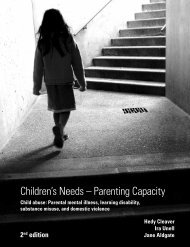Growth and development.pdf
Growth and development.pdf
Growth and development.pdf
You also want an ePaper? Increase the reach of your titles
YUMPU automatically turns print PDFs into web optimized ePapers that Google loves.
The rate of child protection referrals increased significantly between 1998 <strong>and</strong> 2000, but thereferral rate is lower than in many other authorities. However, rates of children subject to acase conference <strong>and</strong> placed on the child protection register are high. The category showingthe most significant increase is neglect. The number of stranger adoption applicationsincreased significantly between 1998 <strong>and</strong> 2000.The Council is using the Children Services Development Fund (CSDF) - together with fundsfrom health <strong>and</strong> the Surestart programme to develop a wide range of services including:• enhanced community support for looked after <strong>and</strong> vulnerable children <strong>and</strong> families;• expansion of respite care arrangements <strong>and</strong> specialist fostering for children with complexneeds;• community <strong>and</strong> school based mental health <strong>development</strong>s; <strong>and</strong>• extra care <strong>and</strong> support to the age of 18 <strong>and</strong> beyond for looked after children.Following publication of Learning with Care, the Council has established a joint protocol foreducation <strong>and</strong> social work services to deal with the education of looked after children. Itaddresses the respective roles <strong>and</strong> responsibilities of parents, education <strong>and</strong> social work staff.The Council is working towards full implementation of the recommendations throughout 2002.Notwithst<strong>and</strong>ing major shortages in qualified social workers, the Council has an action plan inplace for ensuring that all looked after children have a care plan. This has not yet beenachieved.Glasgow has linked its social work <strong>and</strong> education information systems (CareFirst <strong>and</strong> SEEMIS)to access information about the education of looked after children. A joint Education/SocialWork team provides in-school <strong>and</strong> in-home support to looked after children. A post withinSocial Work Services has a dedicated remit to monitor <strong>and</strong> evaluate progress in relation to theeducational achievement of looked after children.Preparations for the new arrangements for care leavers are well advanced. In a partnershipwhich embraces accommodation, support, education, training <strong>and</strong> health services, a specialistleaving care team assesses all young people who are looked after <strong>and</strong> accommodated at 15years of age.The Council sees education <strong>and</strong> employment as key determinants of the future prospects ofcare leavers. A Council training scheme for care leavers, with 50 places a year, provides themwith vocational training, such as in horticulture or building trades <strong>and</strong> the offer of an interviewfor a long term job with the relevant Council department.The Council, alongside its joint planning partners in the NHS <strong>and</strong> other external agencies hasdeveloped effective planning structures for children’s services. The Joint Strategy Group, whichis a multi-agency forum set up to progress strategy <strong>and</strong> planning across the spectrum ofchildren’s needs as reflected in the Children’s Services Plan, is accountable to the Council’sJoint Education <strong>and</strong> Social Work Children’s Services Sub-Committee.138
















